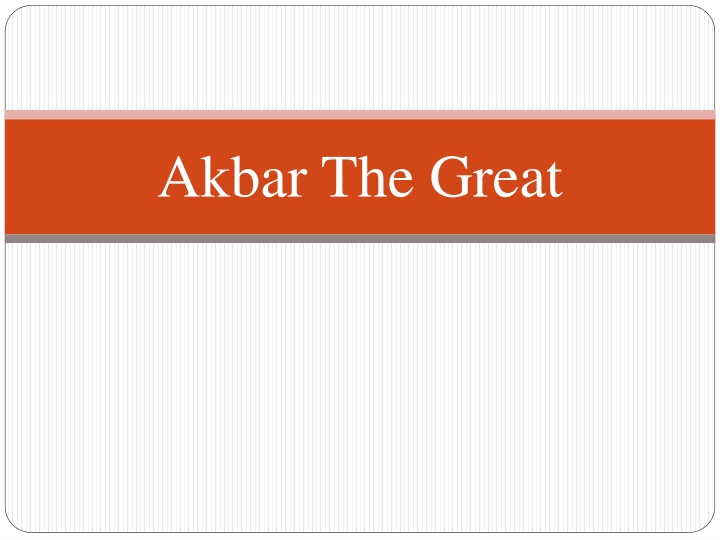
Akbar the Great: Administration and Rule Overview
Learn about the administration and rule of Akbar the Great, the Mughal emperor. Discover how he maintained a centralized government, implemented provincial administration, and managed military and financial affairs efficiently during his reign. Explore his strategic leadership and organizational structure that helped him govern effectively.
Download Presentation

Please find below an Image/Link to download the presentation.
The content on the website is provided AS IS for your information and personal use only. It may not be sold, licensed, or shared on other websites without obtaining consent from the author. If you encounter any issues during the download, it is possible that the publisher has removed the file from their server.
You are allowed to download the files provided on this website for personal or commercial use, subject to the condition that they are used lawfully. All files are the property of their respective owners.
The content on the website is provided AS IS for your information and personal use only. It may not be sold, licensed, or shared on other websites without obtaining consent from the author.
E N D
Presentation Transcript
Introduction After Humayun s death, his thirteen year old son, Akbar, was proclaimed emperor As Akbar was too young, Bairam Khan, Humayan s faithful and experienced general looked after the affairs of the government on his behalf The Mughal throne was unstable and insecure It was threatened by enemies on all sides Adil Shah, the nephew of Sher Shah was determined to re- established the Afghan rule by capturing the throne of Delhi. The Rajputs had becomes powerful and were waiting for an opportunity to overthrow the Mughals.
Administration of Akbar 1. Centralized Government: Akbar was the head of the kingdom under who were all the offices and officials. To reduce the work load he distributed the tasks and goals to different officers in the following manner: Wakeel:They were the chief advisors of the Emperor who headed the administration Diwan:Were of two categories: A. Mansabdars-Who checked audited and controlled the finances. B. Mir Baksh- Officials who distributed pays to senior officials. Sadar- I- Sadr: He was deployed as the head of the religious advisory whose task was to maintain religious unity. Khan- I - Saman:As his title suggests he was the royal Store In-Charge who facilitated the kitchen, social gatherings and the upkeep of palace interiors. Muhatib: He was like the royal counselor who was In-charge of the upkeep of Muslim ethics and culture. Kotwaal: He was the head of the Intelligence and postal department who kept records of new immigrants.
2. The Provincial Administration Under the rule of Akbar the kingdom was divided into 15 Subas to manage the administration without any problems. These Subas were allotted to officials who kept a close account of all the activities that took place. These officials were: Subedar: He was the overall In-charge of Provincial development. Diwaan: He solicited the matters of finances and bills. He took charge of giving pays to the provincial officers. Sadr: He took care of state level judicial matters and helped people who were needy to get charity. Qazi: He was a local judge who took care of small judiciary matters that could be solved in small time limits. Kotwaal: He took charge of the law and order situation on state levels. Mir Baksh: He was In-Charge of local taxes and collection of revenue for the state welfare. Waqr-I-Nawis:They were secret detectives and spy services. 3. Military Administration According to the historians Akbar had the most well equipped and decorated army with high morals which were the result of a planned system. The army officials under the Mansabdars took care of all the following needs of the soldiers: a. Getting pay on time b. Taking care of the well being of injured soldiers c. Granting them tax free rations. d. Regular health check ups and awarding the deserving soldiers.
4. Financial Administration Land was the main source of earning income during that times.The main officer who took care of the process was the Finance Officer Raja TodarMall who excelled in financial matters and exerted the idea of measuring the land on the scales of BIGHAS. He classified the land into four divisions that were: a. POLAJ Land that was cultivable all throughout the year and gave rich harvests. b. PARAUTI- Land left fallow after one harvest for almost 2 years to regain lost fertility. c. CHHACHHAR- Land used for one harvest then left fallow for 4 to 5 years. d. BANJAR The infertile land that was not cultivable.
5. The Legislative Administration Akbar was a very judicious ruler who reformed the judicial system according to the Hindu laws. He was a true democrat who valued the feelings and ethical values of his people. He had separate laws for Muslim or Islamic laws. During Akbar s reign there were many courts, the highest in rank being the King himself. The King had the authority to pronounce capital punishment. Akbar s infallible administrative system proves his very wise acumen for bringing about greater changes in the political chaos of a country which was an amalgamation of a bouquet of religions; the major ones being the Hindus and the Muslims. But Akbar s approach to see this geo-political situation in a systematic approach was what gave birth to the Federal Administrative system, which is practiced even today in many countries of the world.
Akbar Religious Policy The policy introduced by Akbar treated every religion with respect and equality. He always tried to maintain peace and harmony between people of different faith. He also founded a new religion called 'Din-i-Ilahi' having all the common points from all the religions.
